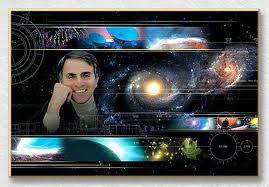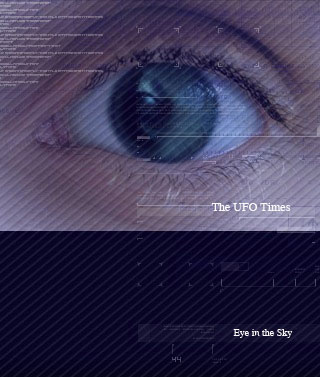|
|

The power of Cosmos lies in Sagan’s inspirational delivery of its main contention — our oneness with the Cosmos. To view Cosmos is one of the most spiritually uplifting experiences, made all the more remarkable because it is a science series. For example, it explains how we, and all the creatures with which we share the Earth are all made of star stuff, from the elements in our own bodies including the calcium in our bones, the iron in our blood, to the carbon in each and every cell. Whilst the first light elements such as hydrogen and helium were formed at the time of the Big Bang nucleosynthesis, the heavier elements, such as nickel, copper, iron and oxygen were synthesized in the nuclear furnaces of long-dead stars, many of which became supernovae. The heavy chemical elements, were a product, once this first generation of stars had used all of their hydrogen nuclear fuel.
Sagan movingly sums up the whole process in the introduction to both the series and the book that in effect, the Cosmos, is all that is, all that has been, and all that ever will be. Through a process of nearly fourteen billion years of cosmic evolution, and later Darwinian Natural Selection, humans evolved and became a very special part of this cosmos. In effect, through mankind, the cosmos has evolved its very own intelligence and consciousness – star stuff harvesting starlight and enquiring about its own existence.
In taking complex scientific theories and concepts such as Special Relativity, Darwinian Selection and Atomic Theory and presenting them in a correct, yet readily understandable form, without the need for complex mathematics, Sagan realized the importance for mankind’s future wellbeing of the public’s understanding of science and involvement in what both he and Druyan termed the Scientific Enterprise. Despite making scientific knowledge easily accessible to a the general public he received many criticisms from the scientific elite, many no doubt jealous of his deserved celebrity status, or annoyed at his attacks on vested interests. His explanation in Cosmos of Special Relativity, “Journeys in Space and Time”, remains one of the most eloquent and understandable introductions to the subject, enticing the reader or viewer to delve deeper.
The issue of scientific advocacy repeatedly appears throughout Sagan’s many books including Pale Blue Dot: A Vision of the Human Future in Space and The Demon Haunted World: Science as a Candle in the Dark. He uses the example of the destruction of Ptolemy II’s Great Royal Library in Alexandria in 415AD, and the murder of Hypanthia, its last librarian and the world’s first female mathematician by the mob, as an example of what can happen when knowledge is kept secret by a ruling elite. The result of the destruction of the Great Library, and the Ionian civilization centuries before was the loss of knowledge of incalculable value amassed over a thousand years, and the start of a dark epoch in human history. This epoch was characterized by mysticism, bigotry, racial and religious extremism and hatred and witchcraft, ending only with Copernicus, Johannes Kepler, Tyco Brahe and Galileo Galilei and Giordano Bruno (many of whom even in the seventeenth century were being persecuted by the Roman Catholic Church, and indeed in the case of Bruno murdered for the heretic act of speculating about a galaxy brimming with exo-planets and extraterrestrials).
Neither has the threat to our present civilization from ignorance evaporated. In Pale Blue Dot, Sagan notes how we (in western civilization) have contrived to produce advanced societies based primarily on high technology and science where only a small fraction of the population has any scientific knowledge. This, according to Sagan, coupled with the growth in religious extremism, racial hatred, superstition, the supernatural and pseudoscience is a recipe for disaster, and one, given our advanced weaponry will sooner, or later, explode in our faces.
Sagan appeals to scientists and science enthusiasts alike to become advocates for the subject. Instrumental in both the Viking landings on Mars in the summer of 1976 and the Voyager missions to the outer planets in the 1980s, he uses the Voyager 1 “Pale Blue Dot” photograph of the Earth as an example. Senior administrators at NASA did not want to waste resources re-configuring the spacecraft to take a photograph of the Earth from six billion kilometers. Sagan appealed above their heads citing the immense public interest of the photograph. After all, he stated the US public was funding NASA and as paymasters they had a right to witness what would become one of the most famous photographs of all time – the Earth as a pale blue mote of dust suspended in a sunbeam. It is by no means certain that humanity will avoid self-destruction either through environmental degradation or through weapons of mass destruction (and there are more than adequate quantities still available).
In both Cosmos and Pale Blue Dot, Sagan speculates that simultaneously to gaining interstellar communications ability, civilizations also gain atomic physics, and perhaps more-or-less immediately use nuclear weapons to engage in self-destruction. Perhaps this is why we have not been visited by ET. Or, as Sagan says, perhaps ET is constantly dealing with its self-generated environmental degradation. But above all else, Sagan, in all his science advocacy is an optimist and believes that humanity can and will rise above the challenges posed by our very nature, the juxtaposition of our technology with beliefs, and the disasters that nature can throw at the Earth, such as asteroid impacts. It will be achieved, he says, by the same scientific enterprise with its proven successful method of critically independently verified facts and theories, not by superstitions, ufology or mysticism.
Scientists have made astonishing leaps forward in the past 400 years, for example in technology and medical sciences — infact in virtually every area of modern advanced industrial society. Compare that, Sagan says, with what other areas of human thought and belief have provided in improving the lives of the populace. Instead of wanting to believe in something amazing — do something amazing. Add to the body of human knowledge about the cosmos, or show a child the Andromeda Galaxy. Show them how the light, the fastest thing we know has taken a staggering 2.5 million years to reach our eyes! Inspire them to naturally develop that innate human curiosity about science and the universe in which we live.
Sagan powerfully states in Cosmos that it is the birth rite of every child, of every generation to gain knowledge about their place in the universe, and to critically evaluate such knowledge and facts. To do less would risk being taken in by the first charlatan character, perhaps even on a societal scale – and there are plenty of examples of that in human history. Extraordinary claims do indeed require extraordinary evidence. As Sagan says, there are no authorities in science; it’s a totally democratic subject, relying on verified facts, and theories that are readily falsifiable. Yet it’s also a very human and creative subject. No one knows from which ranks the next Einstein, or Newton will come.
No article on Carl Sagan would be complete without mentioning Contact. The book, upon which the movie that followed it is largely based, was written by Carl Sagan and published in 1985. Some of Sagan’s character traits are evident in the main character, Ellie Arroway, and the novel serves as an enthralling platform in which he encapsulates ideas surrounding many of his life’s interests, especially the first contact with extraterrestrials. A film adaptation of Contact, starring Jodie Foster, was released in 1997. Without spoiling the film, for those yet to view it, Dr. Ellie Arroway (Jodie Foster), after years of searching for “the truth” in radio astronomy, finds conclusive radio astronomical proof of intelligent aliens, who have been receiving our first radio and television broadcasts since the early twentieth century. The aliens send plans of how the human race can construct a machine of immense technology using wormholes (the scientific theory behind this was confirmed as correct by Sagan’s fellow scientist and colleague, Kip Thorne). Ellie’s role in the movie is juxtaposed with that of Palmer Joss (Matthew McConaughey). He has spent his life searching for “the truth” through faith in God. This first radio “contact” means that both Ellie and Palmer, and indeed, everyone on Earth, are forced to challenge their own assumptions. In the inevitable first contact, will humankind be able to find a compromise between science and belief? If any movie is worth watching – this is it!
Tragically, Sagan died in December 1996, after a long fight with myelodysplasia, a rare form of bone cancer at the comparatively young age of 62. A voice of reason and science in a world where superstition and mysticism are once again in the ascendancy, he was one of those talented individuals humanity, at a critical juncture in its history, could least afford to lose. The challenge is for his readers, viewers and students to pick up the gauntlet.
If you ever endeavor to rationalize why you are so avidly interested in astronomy and cosmology, re-visit Carl Sagan’s vast astronomical bequest to the public. He succinctly explains why we tingle at the thought of the cosmos and long to leave the Earth — it’s in our genes to return to the stars. More importantly you realize the immense importance of science, and of inspiring your children, or the young generation generally with the subject. Yet you are probably depressed at the degradation and sensationalisation of science documentaries on television. If this is the case, and you get the chance, watch or read Cosmos or read any of Sagan’s other publications. Allow this potent master of the Cosmos into your homes and let him inspire your families, friends and importantly youngsters in taking an interest in science.
The proof of Sagan’s potent teaching and inspiration lies in many of his students and colleagues who have gained leading roles in space exploration. These include Carolyn Porco, a leading US planetary scientist, Director of the Hayden Planetarium, New York and PBS-Nova presenter Neil deGrasse Tyson, and Steve Squyres, principal investigator of the NASA Mars Exploration Rovers, Spirit and Opportunity. On a personal level, had it not been for a chance viewing of the PBS Cosmos series a five years ago, you would not be reading this now, and neither would you see myself or my son, thoroughly relishing our visits to our local planetarium, or our nights out under the stars with our trusty old telescope!
